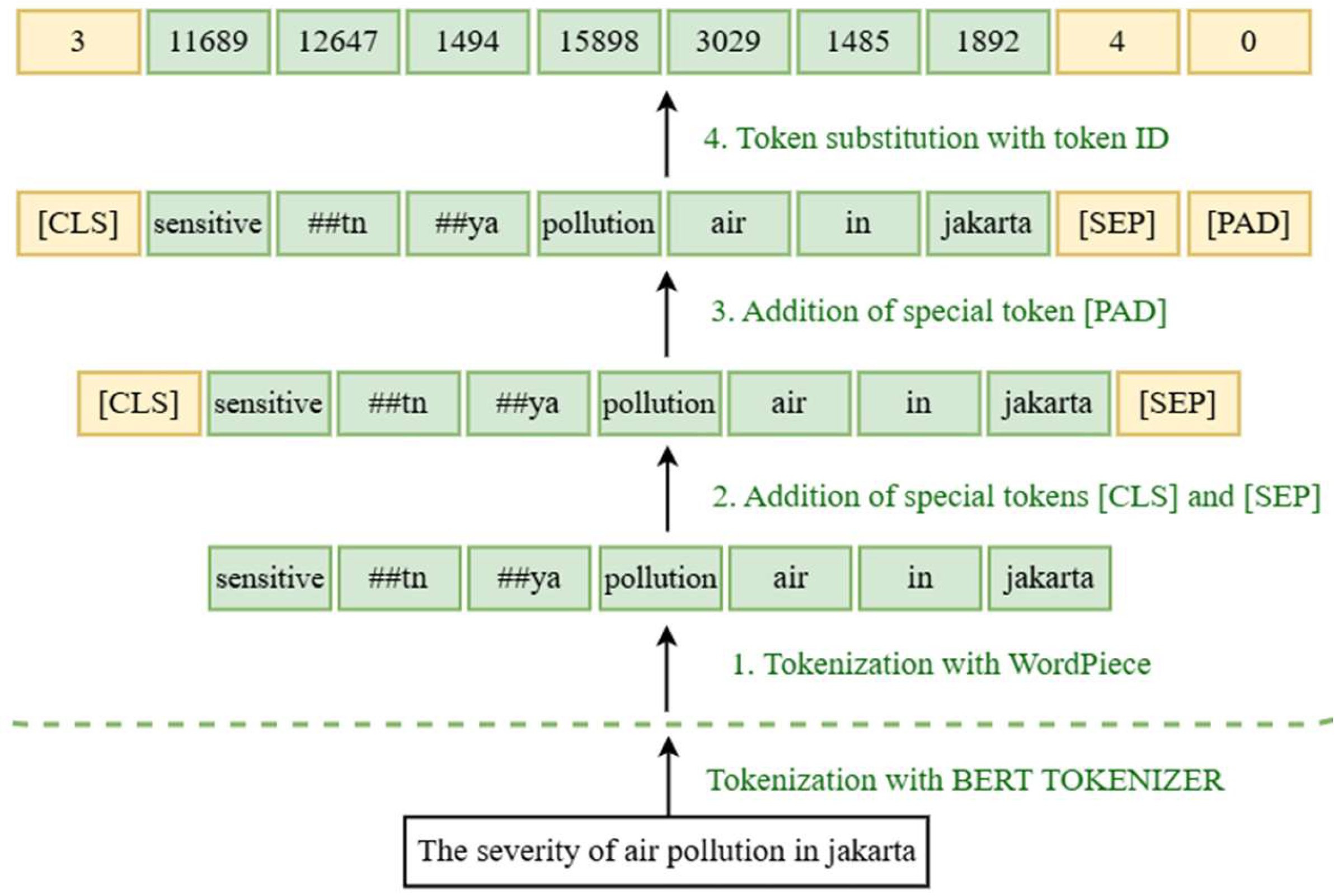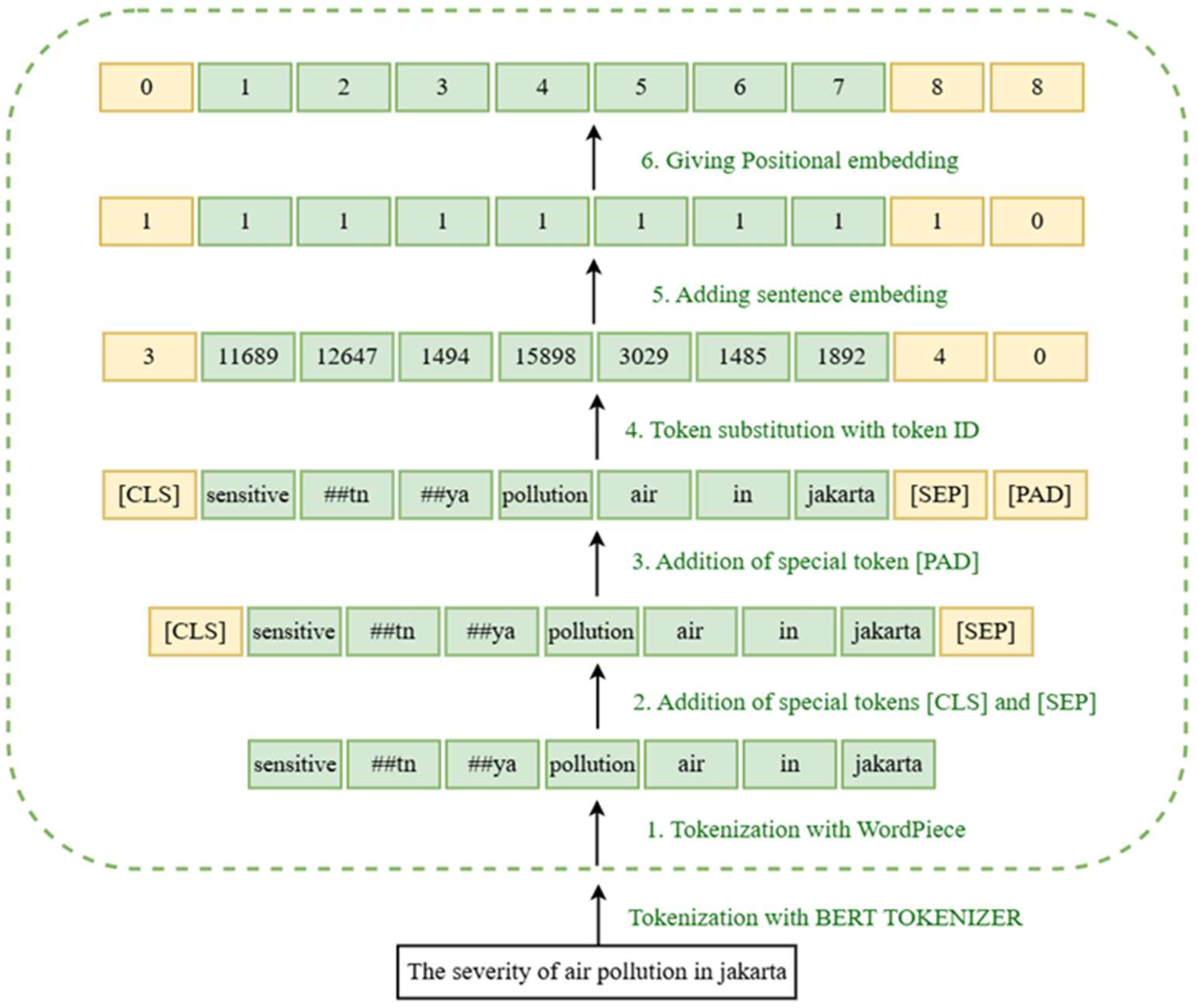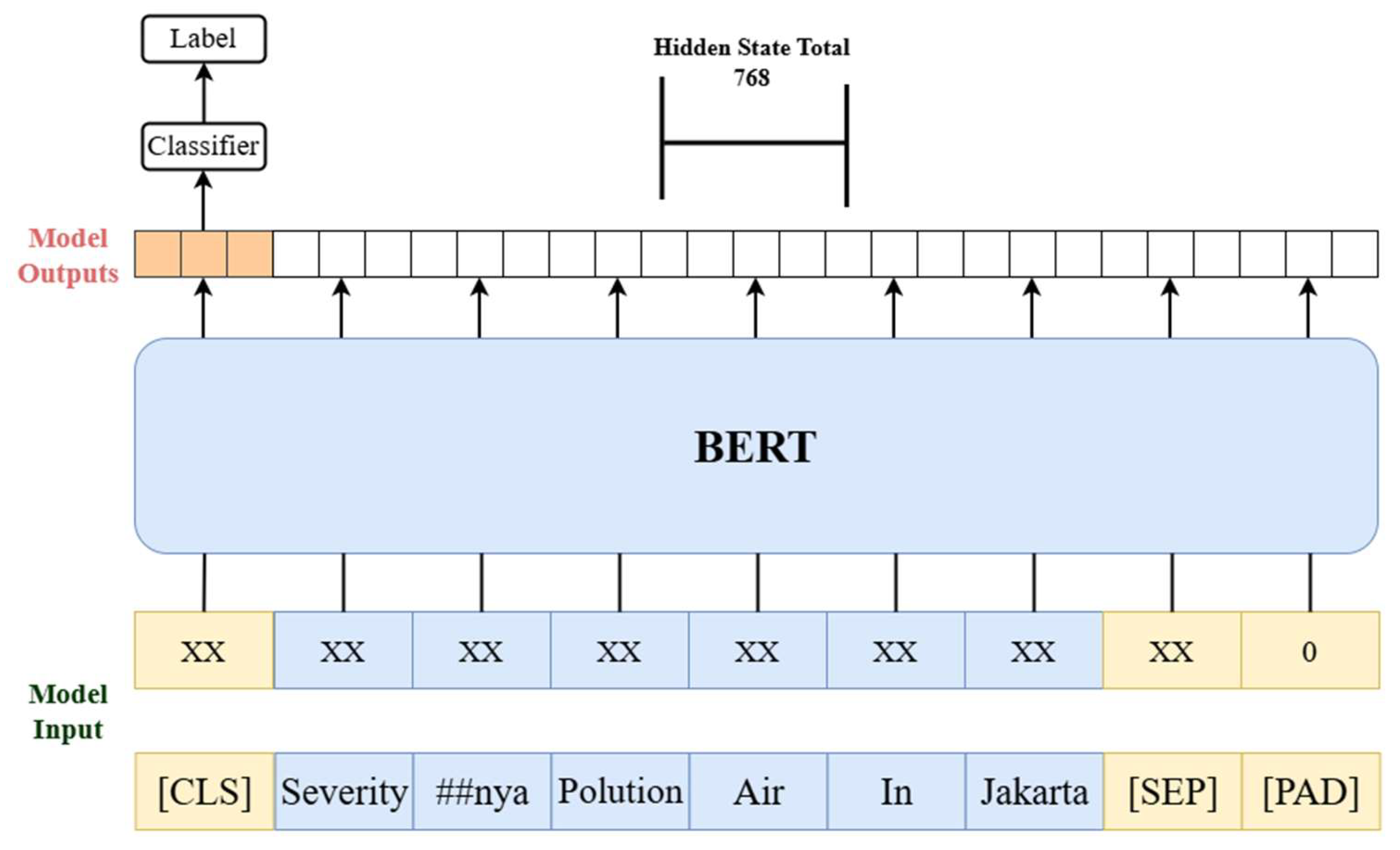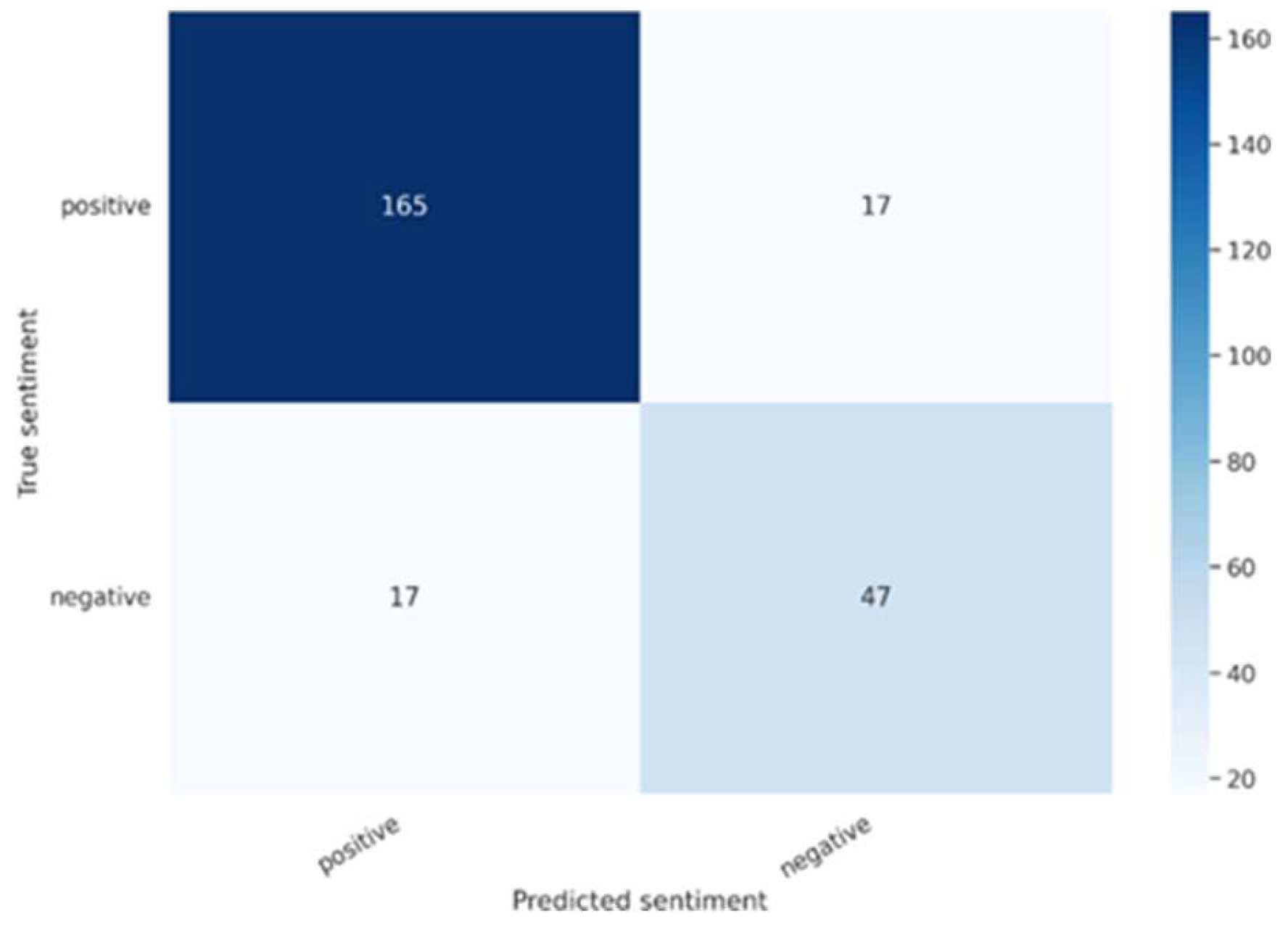Sentiment Analysis of Air Pollution in Jakarta Using the Bidirectional Encoder Representations from Transformers (BERT) Method †
Abstract
1. Introduction
2. Materials and Methods
2.1. Data Collection
2.2. Labelling
2.3. BERT Input Representation
2.4. BERT Model Training
2.5. Testing
3. Results and Discussion
4. Conclusions
- This research has good accuracy, recall, precision, and F score values so it is good to use in a sentiment analysis system.
- This research produces sentiment values and produces good accuracy values with 86%, precision 90%, recall 90% and F score 90%.
Author Contributions
Funding
Institutional Review Board Statement
Informed Consent Statement
Data Availability Statement
Conflicts of Interest
References
- Febriansyah, I.; Fikry, M.; Yusra. Sentiment Analysis on Twitter of Anies Baswedan as a 2024 Presidential Candidate Using the K-Nearest Neighbor Method. G-Tech J. Teknologi Terapan 2023, 7, 1061–1070. [Google Scholar] [CrossRef]
- Chandradev, V.; Suarjaya, I.M.A.D.; Bayupati, I.P.A. Hotel Review Sentiment Analysis Using BERT Deep Learning Method. J. Buana Inform. 2023, 14, 107–116. (In Indonesian) [Google Scholar] [CrossRef]
- Ati, G.R.; Prasetyaningrum, P.T. Analysis of Community Sentiment Towards Free Nutrition Meal Programs on Twitter Using Naïve Bayes, Support Vector Machine, K-Nearest Neighbors, and Ensemble Methods. J. Inf. Syst. Informatics 2025, 7, 1443–1460. [Google Scholar] [CrossRef]
- Purwanto, D.D.; Honggara, E.S. Classification of Air Pollution Standard Index Calculation Results with Gaussian Naive Bayes (Case Study: ISPU DKI Jakarta 2020). J. Intell. Syst. Comput. 2022, 4, 102–108. (In Indonesian) [Google Scholar] [CrossRef]
- Kurniawan, B.; Aldino, A.A.; Isnain, A.R. Sentiment analysis of the Electronic System Operator Policy (PSE) Using the Bidirectional Encoder Representations from Transformers (BERT) Algorithm. J. Teknol. Dan Sist. Inf. 2022, 3, 98–106. (In Indonesian) [Google Scholar]
- Saputra, N.; Nurbagja, K.; Turiyan. Sentiment analysis of presidential candidates Anies Baswedan and Ganjar Pranowo using Naive Bayes method. J. Sisfotek Glob. 2022, 12, 114–119. [Google Scholar] [CrossRef]
- Solihin, F.; Awaliyah, S.; Shofa, A.M.A. Utilisation of Twitter as a media for information dissemination by the Communication and Informatics Office. JPIPS 2021, 13, 52–58. (In Indonesian) [Google Scholar]
- Umri, S.S.A.; Firdaus, M.S.; Primajaya, A. Analysis and Comparison of Classification Algorithms in the Air Pollution Index in DKI Jakarta. JIKO (J. Inform. Dan Komput.) 2021, 4, 98–104. [Google Scholar] [CrossRef]
- Wicaksono, D.W.; Hartono, B. Sentiment analysis on Twitter towards Jakarta air quality using the NBC method. ELKOM 2024, 17, 103–110. (In Indonesian) [Google Scholar]
- Atmaja, R.M.R.W.P.K.; Yustanti, W. Sentiment analysis of customer review of Ruang Guru application with BERT method (Bidirectional Encoder Representations from Transformers). J. Emerg. Inf. Syst. Bus. Intell. 2021, 2, 55–62. (In Indonesian) [Google Scholar]
- Munikar, M.; Shakya, S.; Shrestha, A. Fine-grained sentiment classification using BERT. arXiv 2019, arXiv:1910.03474. [Google Scholar] [CrossRef]
- Fahriyani, S.; Harmaningsih, D.; Yunarti, S. The use of Twitter social media for disaster mitigation in Indonesia. J. IKRA-ITH Hum. 2020, 4, 56–65. (In Indonesian) [Google Scholar]
- Pramono, J.S.; Nuraini; Djamaluddin, J.; Hijriyati, Y.; Yusriati. The Effect of Air Pollution on the Health of Urban Residents (Case Study in Jakarta). Miracle Get J. 2025, 2, 34–43. [Google Scholar] [CrossRef]











| Sentiment | Explanation |
|---|---|
| 1 | Comments containing solutions and hopes regarding air pollution in Jakarta. |
| 0 | Comments that express a negative view of air pollution in Jakarta and could potentially have an adverse impact on readers or the public detailing concerns or criticisms of the air pollution situation. |
| Sentiment | Comment |
|---|---|
| 1 | in Jakarta. This tree planting effort is the right step in overcoming air pollution problems, because trees act as carbon dioxide absorbers and oxygen producers. In addition, tree planting also has aesthetic value and can beautify the surrounding area. |
| 0 | It’s useless to exercise outdoors if Jakarta’s air is still heavily polluted! |
| 0 | Finally a breath of fresh air, in Jakarta it’s pollution. |
| 1 | It’s good to make more green open spaces in Jakarta, just in case air pollution can also be reduced. |
| 0 | In Jakarta, I met air pollution. In Palembang, I found haze due to forest and land fires:) So sad, I expected to see blue clouds and clean air but I didn’t:) |
| 1 | Hundreds of water mist devices have been installed in buildings in South Jakarta, West Jakarta and East Jakarta to tackle air pollution. |
Disclaimer/Publisher’s Note: The statements, opinions and data contained in all publications are solely those of the individual author(s) and contributor(s) and not of MDPI and/or the editor(s). MDPI and/or the editor(s) disclaim responsibility for any injury to people or property resulting from any ideas, methods, instructions or products referred to in the content. |
© 2025 by the authors. Licensee MDPI, Basel, Switzerland. This article is an open access article distributed under the terms and conditions of the Creative Commons Attribution (CC BY) license (https://creativecommons.org/licenses/by/4.0/).
Share and Cite
Anjani, S.A.; Septiani, M.; Alfauzi, F.; Saepudin, S.; Muslih, M.; Irawan, C. Sentiment Analysis of Air Pollution in Jakarta Using the Bidirectional Encoder Representations from Transformers (BERT) Method. Eng. Proc. 2025, 107, 131. https://doi.org/10.3390/engproc2025107131
Anjani SA, Septiani M, Alfauzi F, Saepudin S, Muslih M, Irawan C. Sentiment Analysis of Air Pollution in Jakarta Using the Bidirectional Encoder Representations from Transformers (BERT) Method. Engineering Proceedings. 2025; 107(1):131. https://doi.org/10.3390/engproc2025107131
Chicago/Turabian StyleAnjani, Shiva Aulia, Mya Septiani, Fawwaz Alfauzi, Sudin Saepudin, Muhamad Muslih, and Carti Irawan. 2025. "Sentiment Analysis of Air Pollution in Jakarta Using the Bidirectional Encoder Representations from Transformers (BERT) Method" Engineering Proceedings 107, no. 1: 131. https://doi.org/10.3390/engproc2025107131
APA StyleAnjani, S. A., Septiani, M., Alfauzi, F., Saepudin, S., Muslih, M., & Irawan, C. (2025). Sentiment Analysis of Air Pollution in Jakarta Using the Bidirectional Encoder Representations from Transformers (BERT) Method. Engineering Proceedings, 107(1), 131. https://doi.org/10.3390/engproc2025107131






